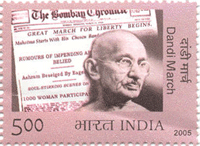|
1. The sale or production of salt by anyone but the British government was a criminal offence punishable by law in India in 1930.
True
False |
2. That salt tax was one of many economic means used to generate revenue to support the British colonial rule.
True
False |
3. Only agricultural labourers needed salt, a mineral which people could collect themselves for free.
True
False
|
4. Gandhi decided to write to Viceroy Lord Irwin, (British governor general of India who represented the British sovereign) to ask for his opinion regarding this tax.
True
False |
5. Lord Irwin, the Viceroy, supported Gandhi's ideas.
True
False
|
6. Gandhi thus decided to organise a march to to collect salt in Dandi, a village on the seashore in Gujarat.
True
False |
|
7. He set off on foot for a 200-mile journey from his ashram* in Sabarmati.
True
False
* "Dans l'Inde ancienne, les âshram ou âshrama étaient des ermitages retirés dans la nature, dans la forêt ou la montagne, où les sages vivaient dans la paix et la tranquillité, loin de l'agitation du monde. Si le lieu servait à la pénitence, il était aussi utilisé pour l'éducation, en effet, le même mot est employé pour un lieu dirigé par un guru où des élèves, petits et grands, séjournent pour suivrent les enseignements d'un maître. […]" |
Click on SALT MARCH MAP ORG to discover the itinerary of the journey.
|
|
8. There were many people with him, both men and women.
True
False
|
9. Throughout the journey, people were eager to listen to Gandhi's speeches.
True
False |
10. On April 7th, Gandhi and his satyagrahis reached the coast.
True
False |
11. The British Army was waiting for the crowds to arrive and attacked them.
True
False |
|
12. Upon arrival, Gandhi picked up a very small amount of salt as a gesture of civil disobedience.
True
False
|
13. All over the seacoast of India, thousands of people illegally collected salt and were arrested.
True
False |
14. This march is considered a key turning point in the fight for Indian independence.
True
False |
